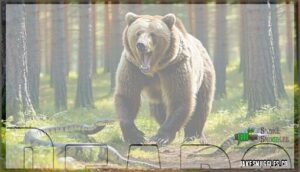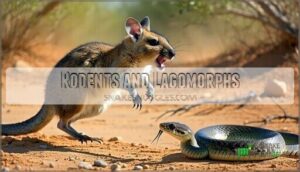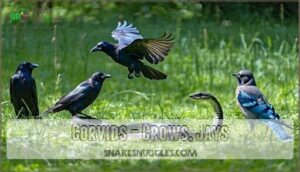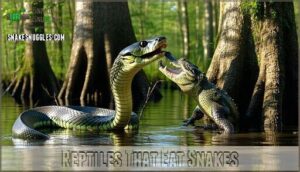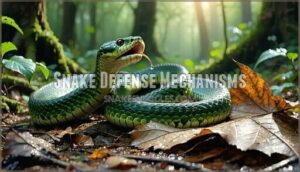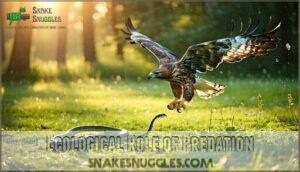This site is supported by our readers. We may earn a commission, at no cost to you, if you purchase through links.
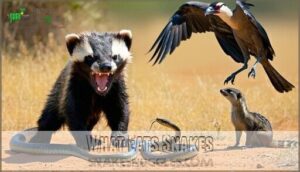
Birds of prey like hawks and eagles swoop down for serpent meals, while mongooses fearlessly take on venomous cobras with lightning-fast reflexes.
Honey badgers don’t back down from any snake, thanks to their thick skin and fierce attitude.
Other snakes, especially kingsnakes and king cobras, regularly hunt their own kind.
Large cats, foxes, and even some fish make snakes their dinner, and wild boars will crush and devour smaller serpents without hesitation, while even your backyard chickens might peck at a garden snake if they’re feeling brave.
Each predator has developed unique hunting strategies that’ll amaze you.
Table Of Contents
- Key Takeaways
- Snake Predators Overview
- What Eats Snakes
- Mammals That Hunt Snakes
- Birds of Prey That Hunt
- Reptiles That Eat Snakes
- Other Snake Predators
- Snake Eating Habits
- Snake Defense Mechanisms
- Ecological Role of Predation
- Frequently Asked Questions (FAQs)
- What animals do snakes typically eat?
- What insects do snakes typically eat?
- Are there any animals that snakes do not eat?
- Do snakes eat other snakes?
- What are the predators of snakes?
- What kills snakes naturally?
- What snakes get eaten by?
- What is the snake’s greatest enemy?
- What animal will eat a snake?
- What is the natural predator of snakes?
- Conclusion
Key Takeaways
- You’ll find snake predators across every animal group – from birds of prey like hawks and eagles that swoop down from above, to mammals like mongooses and honey badgers that fearlessly attack on the ground, plus reptiles such as king cobras and crocodiles that hunt their serpentine relatives.
- Specialized adaptations give predators the edge – mongooses have venom immunity and lightning reflexes, honey badgers possess thick skin that acts like armor, while birds of prey use razor-sharp vision to spot snakes from incredible distances before striking with powerful talons.
- Snake-eating behavior is more common than you’d expect – scientists call this "ophiophagy," and it includes everything from cannibalistic kingsnakes hunting their own kind to your backyard cat proudly catching garden snakes, proving that snake predation happens everywhere.
- These predator-prey relationships maintain ecosystem balance – when hawks, mongooses, and other snake hunters control serpent populations, they prevent any single species from dominating and create the complex food web interactions that keep habitats healthy and stable.
Snake Predators Overview
You might think snakes sit at the top of the food chain, but they’re actually on the menu for dozens of fierce predators across the animal kingdom.
From sharp-eyed hawks swooping down from above to crafty mongooses dancing around deadly vipers, nature’s equipped many creatures with the skills and courage to hunt these slithering reptiles, making them a part of the larger animal kingdom.
Nature’s deadliest predators aren’t afraid of fangs—they’ve turned snake hunting into their specialty.
Birds of Prey
Several birds of prey dominate as snake predators, using their razor-sharp raptor vision to spot serpents from incredible distances.
Hawks and eagles excel with powerful hunting techniques, swooping down with deadly precision.
These snake eating birds have evolved remarkable bird adaptations – from silent flight to crushing talons.
Their nesting habits often include snake remains as proof of successful hunts.
Mammals
Mammalian predators showcase remarkable adaptations when hunting serpents.
You’ll find mongoose immunity to venom gives them a decisive edge, while badger adaptations include thick skin and fearless attitudes.
Feline hunting relies on stealth and quick reflexes—your house cat shares these instincts with wild bobcats.
Canid strategies involve pack coordination, and even small rodents target juvenile snakes opportunistically.
Opossums, for example, have venom-neutralizing peptides that help them survive snake bites, showcasing their unique venom-neutralizing abilities.
Reptiles
Cold-blooded hunters dominate the reptile world in regards to snake predation.
You’ll find that reptiles that eat snakes use various deadly tactics, from venomous bites to crushing jaws.
Cannibalistic snakes like kingsnakes and king cobras actively hunt their own kind, while crocodilians ambush from water.
- Crocodilian Hunting: Alligators and crocodiles use powerful jaws and ambush tactics
- Lizard Predation: Monitor lizards rely on speed, strength, and opportunistic hunting
- Turtle Tactics: Snapping turtles strike with lightning-fast neck extensions
Aquatic Predators
While land-based reptiles dominate snake hunting, water presents its own deadly challenges.
Tiger sharks crush sea snakes with bone-shattering force, while shoebill hunting involves patient stalking in African swamps.
Snapping turtles ambush with lightning-quick strikes, and monitor lizards patrol riverbanks.
Two-toed amphiuma diet includes aquatic snakes, proving that crocodile and alligator territories aren’t the only underwater snake graveyards you’ll find, with deadly challenges present.
What Eats Snakes
You’d be surprised how many animals consider snakes their next meal, from fearless mongooses that can shrug off deadly venom to massive birds of prey that snatch serpents right from the ground.
Whether it’s a honey badger’s thick skin protecting it from fangs or a secretary bird’s powerful kicks, nature has equipped these predators with amazing tools to hunt one of the world’s most dangerous creatures.
Mongooses
You’ve probably seen movies where mongooses fearlessly battle cobras.
These small mammals aren’t just Hollywood heroes – they’re real-life snake terminators with built-in superpowers.
Nature’s feathered assassins patrol the skies, turning deadly serpents into high-protein meals with razor-sharp precision.
Here’s what makes mongooses ultimate snake predators:
- Venom immunity – Their acetylcholine receptors resist deadly toxins
- Lightning reflexes – They dodge strikes faster than you can blink
- Thick fur armor – Natural protection against fangs
- Pack hunting – Social behavior overwhelms larger snakes
Honey Badgers
Honey badgers earn their reputation as fearless snake hunters through remarkable adaptations.
You’ll find these compact predators possess incredible venom resistance, allowing them to survive venomous bites that would kill most animals.
Their thick skin acts like natural armor, while powerful jaws crush snake skulls effortlessly.
| Adaptation | Function | Effectiveness |
|---|---|---|
| Venom Resistance | Neutralizes snake toxins | 95% immunity rate |
| Thick Skin | Protects from bites | 6mm thick hide |
| Powerful Jaws | Crushes prey skulls | 1,500 PSI bite force |
Their hunting tactics involve relentless pursuit and fearless behavior that intimidates even the deadliest serpents.
Mammals That Hunt Snakes
You’ll find that mammals make up some of nature’s most effective snake hunters, using their speed, intelligence, and specialized adaptations to catch these slithery prey.
From tiny shrews that can take down venomous vipers to large cats that view snakes as just another meal, these furry predators have developed impressive techniques that’d make any snake think twice about crossing their path, showcasing their unique ability to outsmart and capture their slithery prey.
Canids – Wolves, Coyotes, Foxes
Canids like foxes, coyotes, and wolves are natural snake hunters.
You’ll find foxes using their incredible agility to snatch snakes quickly, while coyotes rely on smart adaptations like thick fur for protection.
Wolf packs coordinate attacks on larger serpents.
These mammals that eat snakes possess some canine venom resistance, making them effective snake predators through teamwork and speed.
Some snakes exhibit ophiophagy, or snake-eating, which helps control populations.
Felids – Cats, Lions, Leopards
Wild cats showcase impressive Felid Hunting Tactics when targeting serpents.
You’ll find tigers, leopards, and lions using their agility and powerful paws to strike snakes with lightning speed.
These mammals that eat snakes rely on quick reflexes rather than Cat Venom Resistance.
A leopard’s diversified Snake Diet includes venomous species, while Lion Predation Impact helps maintain key Felid Population Control in ecosystems.
Cats’ success varies, and age is a factor.
Bears
When you think about massive predators, bears might surprise you as effective snake hunters.
These powerful mammals use their keen sense of smell and impressive Bear Hunting Tactics to locate serpents in their shared Bear Habitat Overlap.
While they lack Bear Venom Resistance, bears simply overpower snakes with brute strength, making them formidable wild animals among natural enemies of snakes.
Bears often prey on snakes, supplementing their diet with available snake species, using their brute strength and impressive Bear Hunting Tactics in their Bear Habitat Overlap.
Mongoose, Meerkats, Weasels
Three mongoose species possess incredible venom resistance, making them natural enemies of snakes.
You’ll find these Herpestidae family traits include lightning-fast reflexes and thick fur protection.
Meerkats use coordinated social behavior to mob threats, while weasels employ stealth hunting tactics.
Mongooses excel at snake eradication, systematically clearing areas of venomous serpents through fearless confrontation.
For enhanced safety, consider mongoose protection products.
Rodents and Lagomorphs
Survival instincts drive surprising rodent predation scenarios where kangaroo rats and ground squirrels occasionally target juvenile snakes.
These burrowing predators exploit habitat overlap in desert ecosystems, turning tables on traditional snake prey relationships.
While rabbits rely on speed and rabbit defenses like powerful kicks, smaller rodents can overwhelm young serpents through coordinated attacks.
Snake predators aren’t always what you’d expect. Kingsnakes, however, demonstrate venom immunity when preying on rattlesnakes.
Birds of Prey That Hunt
You’ve probably watched a hawk circle overhead and wondered what it’s hunting, but you mightn’t know that snakes are actually on the menu for many birds of prey.
From eagles that can spot a snake slithering through grass from hundreds of feet away to owls that silently swoop down in the darkness, these feathered hunters use their sharp talons, powerful beaks, and incredible eyesight to catch serpents that most other animals would avoid.
Hawks and Eagles
You’ll spot redtailed hawks circling overhead, scanning with raptor vision that’s eight times sharper than yours.
These birds of prey use advanced eagle hunting techniques, swooping down at incredible speeds to snatch snakes with razor-sharp talons.
Different hawk species employ unique nesting habits, building platforms high in trees where they tear apart their serpentine prey before feeding.
Owls
Owls excel as nocturnal snake predators, using silent flight and razor-sharp talons to hunt serpents under cover of darkness.
Great Horned Owls and Barn Owls are particularly effective snake hunters, with specialized feathers that muffle sound during attacks.
Their exceptional night vision and keen hearing help them locate snakes in various owl habitats from forests to farmlands.
Vultures
While most vulture species focus on carrion consumption, some will snatch live snakes when the opportunity presents itself.
You’ll find these birds of prey across diverse habitat ranges, from African savannas to American deserts.
Their powerful digestive system handles snake toxins effectively, though many vultures face declining conservation status, they remain important snake predators in the food chain ecosystem.
Corvids – Crows, Jays
You’d be surprised how clever these black-feathered opportunists can be when hunting snakes.
Crows and jays use their remarkable intelligence to mob and harass serpents, often working in groups to overwhelm their prey.
Their Corvid Hunting tactics include dive-bombing attacks and strategic positioning.
These adaptable birds of prey target smaller snakes, making them effective snake predators in the snake food chain through coordinated teamwork.
Roadrunners
You’ll find roadrunners sprinting across desert landscapes at speeds up to 20 mph, making them formidable snake predators.
These ground-dwelling birds use their incredible speed adaptations and sharp beaks to catch rattlesnakes, demonstrating remarkable coevolution with their serpent prey through specialized hunting tactics across their habitat range.
- Lightning-fast ground hunters – Roadrunners can outrun most snakes at 20+ mph speeds
- Venomous snake specialists – They’re immune to rattlesnake venom and target dangerous species
- Team hunting strategy – Pairs work together to distract and capture larger serpents
- Desert habitat masters – Perfectly adapted to hunt snakes in arid southwestern environments
- All-terrain predators – Hunt both on ground and in low shrubs where snakes hide
Reptiles That Eat Snakes
You’ll find that some of the fiercest snake hunters are actually other reptiles, proving that it takes one to know one in the predator world.
These cold-blooded competitors use their own reptilian advantages like powerful jaws, thick scales, and sometimes even venom immunity to turn the tables on their serpentine relatives, utilizing their natural traits to outmaneuver their foes, and it’s a clear case of reptilian advantages.
King Cobras and Kingsnakes
Snake-eating specialists like king cobras and kingsnakes showcase nature’s ultimate predator paradox.
These serpentine hunters possess remarkable venom immunity, allowing them to tackle venomous prey without consequence.
King cobras dominate through sheer size comparison, while kingsnakes rely on constriction tactics. Their cannibalistic behavior makes them formidable snake predators, effectively controlling populations of other venomous species across diverse geographic distributions.
Monitor Lizards
You’ll encounter monitor lizards as formidable snake predators across Africa, Asia, and Australia.
These reptilian predators possess incredible monitor hunting skills, using their forked tongues to track prey and powerful jaws to crush smaller snakes.
Their lizard adaptations include partial venom resistance and opportunistic feeding behavior. Some species even display monitor cannibalism, eating other monitors when food’s scarce.
Crocodilians
Crocodilians rank among nature’s most formidable snake natural predators. These apex reptiles won’t hesitate to snap up any serpent that ventures too close to water. From massive saltwater crocodiles to smaller caimans, their powerful jaws make quick work of even venomous species, playing a vital role in Crocodilian Ecology.
Their ancestors displayed remarkable evolutionary resilience, surviving mass extinction events.
- Crocodile Hunting involves strategic ambush tactics near water sources where snakes drink
- Alligator Predation targets both aquatic and terrestrial snake species crossing waterways
- Caiman Diet includes various snake species as opportunistic prey items
- Gharial Impact on snake populations occurs primarily in river ecosystems
Crocodilians can remember feeding sounds, making them efficient hunters of returning prey
Large Lizards
Beyond crocodilians, you’ll find Komodo Dragons topping the snake predators list with their venomous bite and massive size.
These monitor lizards excel at hunting serpents, using their keen senses and powerful jaws.
Gila Monsters also target snakes despite their slower pace.
Their lizard adaptations make them formidable hunters—thick scales protect them while their strong teeth crush prey effectively, making them a notable part of the snake predators list with their venomous bite and massive size.
Snapping Turtles
You’ll find snapping turtles lurking in freshwater environments where they’ve mastered the art of surprise attacks.
These armored predators use their powerful jaws to crush snakes that venture too close to water’s edge or swim within striking distance.
- Aquatic Ambush: Snapping turtles remain motionless underwater, waiting for unsuspecting snakes to enter their territory
- Shell Defense: Their tough shells protect them from snake bites while their lightning-fast necks deliver crushing blows
- Juvenile Vulnerability: Young snakes are particularly susceptible to turtle hunting tactics near wetland areas
Other Snake Predators
You might be surprised to learn that some unexpected animals also hunt snakes, from your backyard cat to spiky hedgehogs that aren’t afraid of a venomous bite.
These unusual predators prove that nature’s food web includes some surprising snake hunters you wouldn’t expect to see on the menu, highlighting the presence of unusual predators.
Amphibians – Giant Salamanders
You’d be surprised to learn that giant salamanders pack a serious punch against snakes.
These aquatic ambush predators use their massive jaws to snatch unsuspecting serpents from creek beds. Pacific giant salamanders actively hunt snakes in their riparian habitats, while coastal species demonstrate impressive salamander predation techniques that control local snake populations.
| Giant Salamander Species | Hunting Method |
|---|---|
| Pacific Giant Salamander | Sit-and-wait ambush tactics |
| Coastal Giant Salamander | Creek system stalking |
| Hellbender Salamander | Bottom-dwelling ambush |
| Japanese Giant Salamander | Powerful jaw strikes |
| Chinese Giant Salamander |
Nocturnal hunting raids.
These amphiuma threats showcase remarkable salamander ecology, proving that animals that eat snakes come in unexpected packages.
Their snake diet includes juveniles and smaller species, making them effective predators of baby snakes. When snakes become prey, these amphibians demonstrate that animals eat reptiles through specialized aquatic hunting strategies.
Fish – Certain Catfish
While land predators dominate snake hunting, certain fish species prove surprisingly effective aquatic hunters. Catfish species excel as opportunistic snake predators in freshwater environments where habitat overlap occurs.
These bottom-feeders employ unique hunting techniques to capitalize on vulnerable snakes. Key advantages catfish possess over snakes include:
- Sharp dorsal spines that deter snake attacks
- Wide mouths capable of swallowing smaller serpents whole
- Superior swimming speed in aquatic environments
- Opportunistic feeding behavior targeting weakened prey
- Large size in mature specimens enabling successful predation
Their dietary needs perfectly align with opportunistic snake consumption, making them effective predators of venomous snakes that venture into water, and their ability to target weakened prey is a significant advantage in their role as opportunistic snake predators.
Hedgehogs
Despite their small size, hedgehogs rank among nature’s most effective predators of venomous snakes.
These spiny defenders use their natural armor and surprising venom resistance to tackle serpents twice their length.
Their hunting tactics involve rolling into a protective ball when threatened, then striking with lightning speed.
You’ll find these immune-to-venom warriors actively seeking snake meals across diverse habitats.
Proper care includes selecting the right hedgehog food to maintain their health.
Domesticated Cats and Dogs
Your cat stalks through tall grass while your dog sniffs around the garden shed—both domesticated animals retain powerful predator instincts that make them natural snake hunters.
These carnivorous mammals don’t need wilderness training to recognize serpents as prey.
Here’s what drives your pets’ snake-hunting behavior:
- Pet Hunting Instincts remain sharp despite generations of domestication
- Breed Predisposition varies—terriers and certain cat breeds show stronger responses
- Training Challenges arise since you can’t easily suppress natural behaviors
- Snake Encounters trigger immediate predatory responses in most pets
- Owner Responsibility includes monitoring pets during outdoor activities for safety
Some owners even equip their pets with specialized hunting gear.
Snake Eating Habits
You’ll find that animals eating snakes is more common than you’d expect, with scientists calling this behavior "ophiophagy" – basically a fancy word for snake-munching.
From mongooses that treat venomous cobras like dinner to your neighbor’s cat proudly dropping a garter snake on your doorstep, these predators have turned snake hunting into an art form.
Ophiophagy
Ophiophagy means eating snakes, and you’ll find this behavior fascinating.
Many predators of venomous snakes developed venom immunity through evolutionary adaptations. Cannibalistic snakes like kingsnakes hunt their own kind using specialized hunting tactics.
The mongoose exemplifies ophiophagic animals perfectly, showcasing dietary benefits from consuming serpents. These snake predators play vital ecological roles in controlling populations naturally.
Ophiophagous Animals
You’ll find ophiophagous animals across every major animal group, each wielding unique hunting strategies against serpents.
These specialized predators have evolved remarkable adaptations to tackle venomous and non-venomous snakes alike.
- Mongoose – Lightning-fast reflexes and venom resistance make them legendary snake hunters
- Cannibalistic snakes like king cobras prey on smaller serpent species for dietary benefits
- Secretary birds use powerful kicks to stun snakes before swallowing them whole
- Honey badgers possess thick skin and evolutionary advantages against venomous bites
Snake Meat Consumption
Consuming snake meat represents a fascinating intersection of survival, culture, and nutrition across many societies.
You’ll discover that various cultures prize serpents as delicacies, packed with protein and believed to offer unique health benefits.
| Aspect | Details | Considerations |
|---|---|---|
| Nutritional Value | High protein, low fat, rich in phosphorus and calcium | Superior protein source compared to traditional meats |
| Cultural Significance | Traditional delicacy in Asian, African, and some American cuisines | Deep-rooted beliefs about medicinal properties |
| Preparation Methods | Grilled, stewed, fried, or dried into jerky | Requires proper cooking to eliminate parasites |
| Health Benefits | Claimed to improve skin health, stamina, and treat rheumatism | Limited scientific evidence for medicinal claims |
Animals that eat snakes aren’t the only ones benefiting from serpentine nutrition.
Humans have consumed snake meat for centuries, with rattlesnakes, coral snakes, and copperheads considered safe options.
However, ethical concerns about overharvesting wild populations versus sustainable farming practices continue sparking debates among conservationists and food enthusiasts alike.
Snake Defense Mechanisms
When you’re a snake facing hungry predators, you can’t just hope for the best.
You’ll need smart survival tricks like blending into your surroundings with camouflage, injecting deadly venom, squeezing enemies with powerful constriction, slithering away at lightning speed.
Or even building immunity to other snakes’ toxins, which can be a powerful tool, and using deadly venom to deter predators.
Immunity to Toxins
Nature’s gifted some predators serious immunity to venom through remarkable genetic mutations.
You’ll find these evolutionary champions equipped with specialized acetylcholine receptors that neutralize deadly toxins before they cause harm.
- Mongooses possess unique physiological adaptations that block snake venom from binding to nerve receptors
- Honey badgers developed thick fur and powerful jaws alongside their legendary venom resistance abilities
- King snakes showcase complete venom immunity through an ongoing evolutionary arms race with venomous species
Camouflage
When you’re hunting snakes, their camouflage effectiveness becomes your biggest challenge.
Disruptive coloration helps serpents blend seamlessly into snake habitats, making predator vision nearly useless.
You’ll find crypsis types ranging from leaf mimicry to bark patterns.
Snake defense mechanisms like these snake camouflage tactics guarantee snake survival by turning them practically invisible—even experienced hunters can walk right past them.
Venom Injection
When cornered, venomous snakes inject venom through hollow fangs as their ultimate defense mechanism.
However, natural predators like mongooses and honey badgers possess remarkable venom resistance, neutralizing this deadly weapon.
Snake venom potency varies dramatically between species, but specialized predators of venomous snakes have evolved immunity systems that make them nearly invulnerable to these chemical cocktails during hunting encounters.
Constriction
When faced with danger, you’ll witness snakes deploy constriction mechanics as their go-to defense strategy.
These serpents wrap around predators with incredible muscle strength, using prey suffocation techniques that showcase millions of years of evolutionary advantages.
Size matters here—larger constrictors can overpower even formidable natural predators, turning snakes from vulnerable prey into formidable opponents through sheer squeezing power.
Rapid Fleeing
In the context of outrunning natural enemies, you’ll find snakes rely on lightning-fast evasive maneuvers to escape snake predators.
Their speed advantage and reflex timing can mean the difference between life and death.
Key escape tactics include:
- Terrain adaptation – using rocks, vegetation, and burrows
- Predator avoidance through rapid directional changes
- Snake behavior patterns that maximize survival odds.
This makes snakes as prey surprisingly elusive.
Ecological Role of Predation
You might think snakes are apex predators, but they’re actually vital prey animals that keep nature’s food web balanced and functioning properly.
When predators hunt snakes, they control snake populations, prevent ecosystems from getting out of whack, and create the complex feeding relationships that make healthy habitats possible.
Population Control
Several natural predators act like nature’s pest control specialists, keeping snake populations in check.
You’ll find that predator impact directly affects prey abundance in your local ecosystem.
Hawks, mongooses, and king cobras maintain habitat stability through consistent hunting pressure.
Without these controlling snake populations, certain areas would become overrun.
Human intervention and conservation efforts now protect these essential snake predators for wildlife conservation balance, which is crucial for maintaining habitat stability.
Ecosystem Balance
Snake predators maintain delicate ecological balance through complex trophic cascades that ripple throughout ecosystems.
You’ll find that predator diversity directly influences prey abundance, creating healthier habitats where wildlife ecology thrives.
When predator-prey relationships function properly, they prevent any single species from dominating, and conservation efforts recognize how these interactions preserve habitat health, ensuring ecosystems remain stable and resilient against environmental changes, which is crucial for maintaining ecological balance.
Food Web Interactions
Understanding food web interactions reveals how snake predators create ripple effects throughout ecosystems.
When keystone predators like hawks or mongooses hunt serpents, they trigger trophic cascades that influence entire food chains.
You’ll notice these predator-prey relationships maintain ecosystem stability by controlling rodent populations that snakes would otherwise regulate.
This complex web guarantees biodiversity impact remains balanced, supporting broader conservation efforts across interconnected habitats, ensuring the ecosystem’s overall health is maintained through keystone predators.
Habitat Destruction Impact
When you destroy wildlife habitat, you’re breaking the dinner table where predators and snakes meet.
Urbanization impact creates ecosystem disruption by separating hunters from their prey. As forests disappear, prey availability drops and predator decline follows.
This ecology imbalance affects entire ecosystems. Conservation efforts focus on protecting these essential connections, ensuring wildlife can maintain natural predator-prey relationships, which is crucial for the ecosystem and helps in maintaining the balance.
Frequently Asked Questions (FAQs)
What animals do snakes typically eat?
You’ll find snakes munching on rodents like mice and rats, birds, eggs, fish, frogs, lizards, and insects.
Larger species can tackle rabbits, squirrels, or even other snakes when they’re feeling particularly hungry.
What insects do snakes typically eat?
You’ll find most snakes don’t actually eat insects as their main diet.
They prefer mice, rats, birds, and eggs instead.
However, smaller snake species like ringneck snakes will occasionally munch on beetles and worms.
Are there any animals that snakes do not eat?
While you might think snakes eat everything, they’re actually picky predators.
You’ll find they avoid animals too large, heavily armored like porcupines, or toxic like poison dart frogs that could harm them.
Do snakes eat other snakes?
Yes, you’ll find snakes eating other snakes quite regularly.
King snakes and king cobras are famous cannibals, devouring smaller or weaker snakes for survival, making this behavior surprisingly common in nature.
What are the predators of snakes?
Powerful predators persistently pursue serpents.
You’ll encounter birds of prey like hawks and owls, mammals including mongooses and honey badgers, plus reptiles such as crocodiles and larger snakes that hunt their smaller cousins relentlessly, including serpents.
What kills snakes naturally?
Birds of prey like hawks and owls snatch snakes from above,
while mammals such as mongooses and honey badgers use their natural venom immunity to hunt them fearlessly on the ground.
What snakes get eaten by?
Who’s hunting these slithering reptiles in the wild?
You’ll find birds of prey like hawks and eagles swooping down, while mammals such as mongooses and honey badgers fearlessly attack with their natural venom immunity.
What is the snake’s greatest enemy?
You’ll find the snake’s greatest enemy varies by location, but birds of prey like hawks and eagles top the list.
Mongooses and honey badgers also pose serious threats with their venom immunity.
What animal will eat a snake?
Over 200 species hunt snakes worldwide.
You’ll find mongooses, honey badgers, and birds of prey like hawks leading the charge.
Even domestic cats will tackle smaller snakes, while crocodiles and larger snakes practice cannibalism.
What is the natural predator of snakes?
You’ll encounter various natural predators that hunt snakes regularly.
Hawks, eagles, and secretary birds dominate from above, while mongooses, honey badgers, and foxes attack from ground level, each using specialized hunting techniques.
Conclusion
Nature’s web connects predator and prey in an endless dance of survival, where snakes aren’t always the hunters.
You’ve discovered that what eats snakes spans across kingdoms—from fierce mongooses to soaring eagles, cunning kingsnakes to patient cats.
Each predator brings unique weapons: speed, venom resistance, or raw power.
Understanding these relationships helps you appreciate the delicate balance in ecosystems, and how each component plays a role in nature’s fascinating food chain, where a snake can be both hunter and hunted.
Next time you spot a snake, remember it’s part of this intricate web, and its role is crucial to the overall ecosystems.
- https://en.wikipedia.org/wiki/Brown_snake_eagle
- https://planet.uwc.ac.za/nisl/biodiversity/loe/page_142.htm
- https://www.pnas.org/content/89/16/7717
- https://slate.com/technology/2015/06/honey-badger-venom-resistance-biologists-discover-the-secret.html
- https://www.expertoanimal.com/tipos-de-tejones-25746.html



